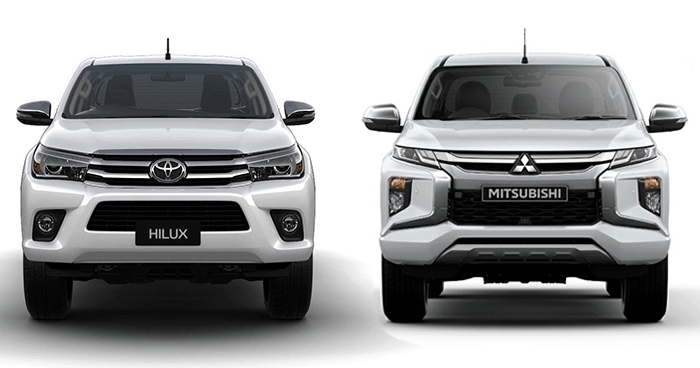Toyota leads the way in Australia and trying to compete against the mighty Hi Lux is like trying to push shit uphill.
The Hi Lux has a well earned reputation for reliability, toughness and getting the job done.
This explains why the Hi Lux was the best selling vehicle in Australia.
Strength and reliability combined with the best advertising and marketing campaigns in the motor industry make Toyota and Hi lux in particular, market leaders.
Is the Mitsubishi Triton able to compete?
Toyota Hi Lux or the Mitsubishi Triton
The Triton gives you a lot of tech and other features for your money.
The Gls features
LED dusk-sensing headlights and daytime running lights, halogen fog lights, chrome door handles, chrome door mirrors with integral heating and turn indicators, speed/rain-sensing wipers, cruise control, reversing and 360-degree cameras plus a rear diff lock.
Keyless entry reveals a sumptuous interior with dual-zone climate control, rear privacy glass, leather-appointed seats with heating up-front, leather-bound steering wheel/gearshift/handbrake and height/reach adjustable steering column. There’s also 12-volt/USB connections and a six-speaker system with 7.0-inch touchscreen, Android Auto and Apple CarPlay, DAB radio and multiple connectivity including Bluetooth.
Beyond its black nudge bar, sports bar, load tub-liner, side steps
and rear-step bumper, there’s chunky six-spoke 18-inch
alloys with 265/60R18 tyres and a full-size spare.
- Longer warranty. Triton comes with a seven-year 150,000 klm warranty.
- The Hi Lux is a five year unlimited klm warranty.
- Styling. Beauty is in the eye of the beholder.
- The Triton has clean lines, is modern and aggressive in its styling.
- The Hi lux has the classic Hi Lux look that lots of people prefer and the Toyota badge that so many people relate to.
- Triton 2.4-litre diesel uses 7.0L/100km. The Hi lux uses 7.1/litres per 100 klm.
- The Triton has Apple CarPlay and Android Auto. It’s so easy to navigate using Google Maps from your phone, respond to texts and while away long journeys by listening to your music on Spotify.
- The HiLux doesn’t have this option.
- It’s not standard on all Triton models though, just the GLX+ and upwards.
- The Triton’s 2.4-litre diesel engine is more torquey and powerful. The Mitsubishi 2.4-litre turbo diesel produces 133kW@3,500rpm and 430Nm@2,500rpm, vs the HiLux’s 110kW@3,400rpm and 343Nm between 1,400rpm and 2,800rpm on a manual gearbox model. A HiLux with an automatic transmission can handle 400Nm@1,600–2,000rpm. However, the HiLux also sells with a more powerful and grunty 2.8-litre diesel.
- Diesel Tritons have a six-speed automatic or manual. The HiLux has a five-speed manual and a six-speed automatic on its 2.4-litre diesel.
- Motoring journalists said the 2019 Triton is class-leading in safety equipment.
- 2019 model rose in price. The motoring media marked the Triton down as prices rose for the 2019 model.
- The Triton has a low towing capacity.
- Toyota claims some HiLux models can tow 3,500kg, whereas the Triton maxes out at 3,100kg.
- Most utes aim for the 3.5-tonne towing benchmark. You could argue that after factoring in payload, trailer ball download and GVM, the Toyota would actually measure nearer to the Triton’s brochure figure.
Toyota HiLux
- HiLux price per service is cheaper. Toyota charges $240 per service on a HiLux. You’ll pay $299 per service at a Mitsubishi dealer for the first 3 years. However, the HiLux servicing costs more over two years due to shorter servicing intervals.
- The HiLux has three engine choices. In the Triton, Mitsubishi only offers two engines, a 2.7-litre petrol and a 2.4-litre diesel. In addition to these engine options, Toyota also produces a meaty 2.8-litre diesel.
- The 4×4 system on the HiLux is only part-time. The Triton has full-time 4WD.
- The HiLux has a wider turning circle. The turning circle for the HiLux measures 12.8 metres, against 11.8 metres on the Triton. In tight inner-city carparks, this could make a huge difference.
- Resale value. According to car valuers, the HiLux retains a higher resale price than the Triton.
- More HiLuxes have a rear diff lock. Essential for keeping going in sticky mud and slippery off-road conditions, only WorkMate HiLuxes lack a rear diff locker, whereas only the top-spec Triton dual cab gets one.
- The HiLux has a manual DPF switch. A nice inclusion on the HiLux diesels, you can manually activate a DPF burn-off when your driving hasn’t triggered a regeneration cycle. A clogged DPF can be very costly to replace and the Triton lacks this feature.
- Reputation. For some people, having the HiLux badge gives them the image and name they desire.
Mitsubishi Triton
Pros
Handy around town
Technology
4WD system
Safety credentials
Longer warranty
Clean modern styling.
Power and Torque
Cons
Towing performance
Bland interior
Toyota HiLux
Pros
Well proven history of reliability.
Good off road and tough conditions.
Huge model range
High retained resale values
2.8-litre diesel option
Toyota badge
Chepaer to service
Cons
Sparse equipment for money
Clunky infotainment system
Unladen ride
Verdict: Which is best, the Toyota HiLux or the Mitsubishi Triton?
The Triton is a great vehicle and is catching or even passing the triton in some areas like tech gadgets, styling and competitive pricing it is still not a Hi Lux.
The Triton offers lots of safety and tech features that the Hi Lux doesn’t and has the ability to use the all-wheel-drive system on tar seal roads.
However, it's hard to discount the HiLux, which routinely tops the overall new car sales figures each month.
It is extremely well made, does everything well and has a very few cons.
A HiLux, has better retained value, they hold value better than the Triton.

